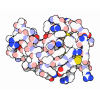+ Open data
Open data
- Basic information
Basic information
| Entry | Database: PDB / ID: 2g4p | ||||||
|---|---|---|---|---|---|---|---|
| Title | Anomalous substructure of lysozyme at pH 4.5 | ||||||
 Components Components | Lysozyme C | ||||||
 Keywords Keywords | hydrolase / Allergen / anomalous substructure of lysozyme crystallized at pH 4.5 | ||||||
| Function / homology |  Function and homology information Function and homology informationLactose synthesis / Antimicrobial peptides / Neutrophil degranulation / beta-N-acetylglucosaminidase activity / cell wall macromolecule catabolic process / lysozyme / lysozyme activity / defense response to Gram-negative bacterium / killing of cells of another organism / defense response to Gram-positive bacterium ...Lactose synthesis / Antimicrobial peptides / Neutrophil degranulation / beta-N-acetylglucosaminidase activity / cell wall macromolecule catabolic process / lysozyme / lysozyme activity / defense response to Gram-negative bacterium / killing of cells of another organism / defense response to Gram-positive bacterium / defense response to bacterium / endoplasmic reticulum / extracellular space / identical protein binding / cytoplasm Similarity search - Function | ||||||
| Biological species |  | ||||||
| Method |  X-RAY DIFFRACTION / X-RAY DIFFRACTION /  SYNCHROTRON / SYNCHROTRON /  FOURIER SYNTHESIS / Resolution: 1.84 Å FOURIER SYNTHESIS / Resolution: 1.84 Å | ||||||
 Authors Authors | Mueller-Dieckmann, C. / Weiss, M.S. | ||||||
 Citation Citation |  Journal: Acta Crystallogr.,Sect.D / Year: 2007 Journal: Acta Crystallogr.,Sect.D / Year: 2007Title: On the routine use of soft X-rays in macromolecular crystallography. Part IV. Efficient determination of anomalous substructures in biomacromolecules using longer X-ray wavelengths. Authors: Mueller-Dieckmann, C. / Panjikar, S. / Schmidt, A. / Mueller, S. / Kuper, J. / Geerlof, A. / Wilmanns, M. / Singh, R.K. / Tucker, P.A. / Weiss, M.S. | ||||||
| History |
|
- Structure visualization
Structure visualization
| Structure viewer | Molecule:  Molmil Molmil Jmol/JSmol Jmol/JSmol |
|---|
- Downloads & links
Downloads & links
- Download
Download
| PDBx/mmCIF format |  2g4p.cif.gz 2g4p.cif.gz | 41.2 KB | Display |  PDBx/mmCIF format PDBx/mmCIF format |
|---|---|---|---|---|
| PDB format |  pdb2g4p.ent.gz pdb2g4p.ent.gz | 28.2 KB | Display |  PDB format PDB format |
| PDBx/mmJSON format |  2g4p.json.gz 2g4p.json.gz | Tree view |  PDBx/mmJSON format PDBx/mmJSON format | |
| Others |  Other downloads Other downloads |
-Validation report
| Summary document |  2g4p_validation.pdf.gz 2g4p_validation.pdf.gz | 413.5 KB | Display |  wwPDB validaton report wwPDB validaton report |
|---|---|---|---|---|
| Full document |  2g4p_full_validation.pdf.gz 2g4p_full_validation.pdf.gz | 415 KB | Display | |
| Data in XML |  2g4p_validation.xml.gz 2g4p_validation.xml.gz | 8.9 KB | Display | |
| Data in CIF |  2g4p_validation.cif.gz 2g4p_validation.cif.gz | 12.1 KB | Display | |
| Arichive directory |  https://data.pdbj.org/pub/pdb/validation_reports/g4/2g4p https://data.pdbj.org/pub/pdb/validation_reports/g4/2g4p ftp://data.pdbj.org/pub/pdb/validation_reports/g4/2g4p ftp://data.pdbj.org/pub/pdb/validation_reports/g4/2g4p | HTTPS FTP |
-Related structure data
| Related structure data | 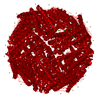 2g4hC 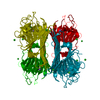 2g4iC 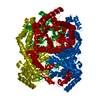 2g4jC 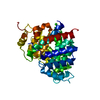 2g4kC 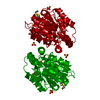 2g4lC 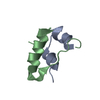 2g4mC 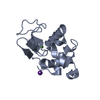 2g4nC 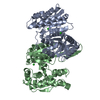 2g4oC 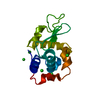 2g4qC 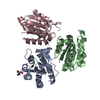 2g4rC 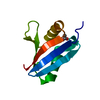 2g4sC 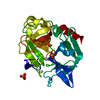 2g4tC 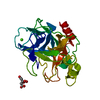 2g4uC 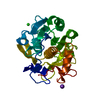 2g4vC 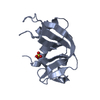 2g4wC 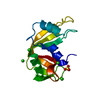 2g4xC 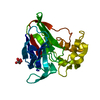 2g4yC  2g4zC 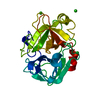 2g51C  2g52C 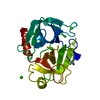 2g55C 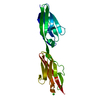 2illC C: citing same article ( |
|---|---|
| Similar structure data |
- Links
Links
- Assembly
Assembly
| Deposited unit | 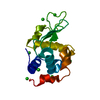
| ||||||||
|---|---|---|---|---|---|---|---|---|---|
| 1 |
| ||||||||
| Unit cell |
| ||||||||
| Components on special symmetry positions |
|
- Components
Components
| #1: Protein | Mass: 14331.160 Da / Num. of mol.: 1 / Source method: isolated from a natural source / Source: (natural)  | ||||
|---|---|---|---|---|---|
| #2: Chemical | ChemComp-CL / #3: Water | ChemComp-HOH / | Has protein modification | Y | |
-Experimental details
-Experiment
| Experiment | Method:  X-RAY DIFFRACTION / Number of used crystals: 1 X-RAY DIFFRACTION / Number of used crystals: 1 |
|---|
- Sample preparation
Sample preparation
| Crystal | Density Matthews: 2 Å3/Da / Density % sol: 38.59 % |
|---|
-Data collection
| Diffraction | Mean temperature: 100 K |
|---|---|
| Diffraction source | Source:  SYNCHROTRON / Site: SYNCHROTRON / Site:  EMBL/DESY, HAMBURG EMBL/DESY, HAMBURG  / Beamline: X12 / Wavelength: 2 Å / Beamline: X12 / Wavelength: 2 Å |
| Detector | Type: MARRESEARCH / Detector: CCD / Date: Jan 1, 2005 |
| Radiation | Protocol: SINGLE WAVELENGTH / Monochromatic (M) / Laue (L): M / Scattering type: x-ray |
| Radiation wavelength | Wavelength: 2 Å / Relative weight: 1 |
| Reflection | Resolution: 1.84→30 Å / Num. obs: 10564 / Observed criterion σ(F): 0 / Observed criterion σ(I): 0 |
- Processing
Processing
| Software |
| |||||||||||||||||||||||||||||||||||||||||||||||||||||||||||||||||||||||||||||||||||||||||||||||||||||||||||||||||||||||||||||
|---|---|---|---|---|---|---|---|---|---|---|---|---|---|---|---|---|---|---|---|---|---|---|---|---|---|---|---|---|---|---|---|---|---|---|---|---|---|---|---|---|---|---|---|---|---|---|---|---|---|---|---|---|---|---|---|---|---|---|---|---|---|---|---|---|---|---|---|---|---|---|---|---|---|---|---|---|---|---|---|---|---|---|---|---|---|---|---|---|---|---|---|---|---|---|---|---|---|---|---|---|---|---|---|---|---|---|---|---|---|---|---|---|---|---|---|---|---|---|---|---|---|---|---|---|---|---|
| Refinement | Method to determine structure:  FOURIER SYNTHESIS / Resolution: 1.84→30 Å / Cor.coef. Fo:Fc: 0.962 / Cor.coef. Fo:Fc free: 0.922 / SU B: 5.241 / SU ML: 0.086 / TLS residual ADP flag: LIKELY RESIDUAL / Cross valid method: THROUGHOUT / ESU R: 0.137 / ESU R Free: 0.132 / Stereochemistry target values: MAXIMUM LIKELIHOOD / Details: HYDROGENS HAVE BEEN ADDED IN THE RIDING POSITIONS FOURIER SYNTHESIS / Resolution: 1.84→30 Å / Cor.coef. Fo:Fc: 0.962 / Cor.coef. Fo:Fc free: 0.922 / SU B: 5.241 / SU ML: 0.086 / TLS residual ADP flag: LIKELY RESIDUAL / Cross valid method: THROUGHOUT / ESU R: 0.137 / ESU R Free: 0.132 / Stereochemistry target values: MAXIMUM LIKELIHOOD / Details: HYDROGENS HAVE BEEN ADDED IN THE RIDING POSITIONS
| |||||||||||||||||||||||||||||||||||||||||||||||||||||||||||||||||||||||||||||||||||||||||||||||||||||||||||||||||||||||||||||
| Solvent computation | Ion probe radii: 0.8 Å / Shrinkage radii: 0.8 Å / VDW probe radii: 1.4 Å / Solvent model: BABINET MODEL WITH MASK | |||||||||||||||||||||||||||||||||||||||||||||||||||||||||||||||||||||||||||||||||||||||||||||||||||||||||||||||||||||||||||||
| Displacement parameters | Biso mean: 21.904 Å2
| |||||||||||||||||||||||||||||||||||||||||||||||||||||||||||||||||||||||||||||||||||||||||||||||||||||||||||||||||||||||||||||
| Refinement step | Cycle: LAST / Resolution: 1.84→30 Å
| |||||||||||||||||||||||||||||||||||||||||||||||||||||||||||||||||||||||||||||||||||||||||||||||||||||||||||||||||||||||||||||
| Refine LS restraints |
| |||||||||||||||||||||||||||||||||||||||||||||||||||||||||||||||||||||||||||||||||||||||||||||||||||||||||||||||||||||||||||||
| LS refinement shell | Resolution: 1.84→1.888 Å / Total num. of bins used: 20
| |||||||||||||||||||||||||||||||||||||||||||||||||||||||||||||||||||||||||||||||||||||||||||||||||||||||||||||||||||||||||||||
| Refinement TLS params. | Method: refined / Origin x: -0.749 Å / Origin y: 20.3737 Å / Origin z: 18.9854 Å
|
 Movie
Movie Controller
Controller



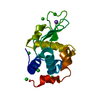
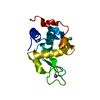
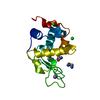

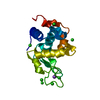
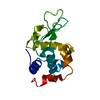
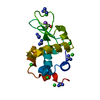
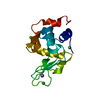
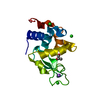
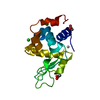
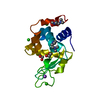
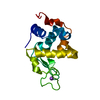
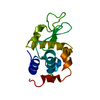
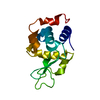
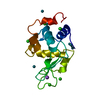
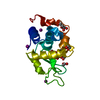
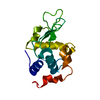
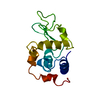
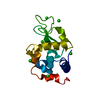

 PDBj
PDBj


